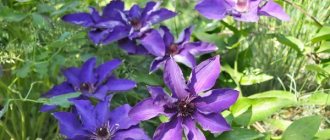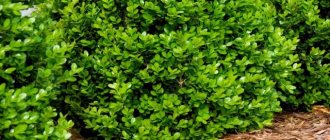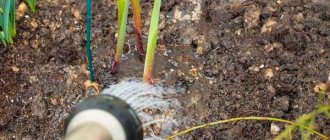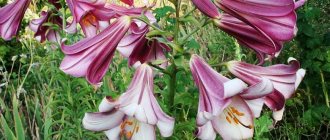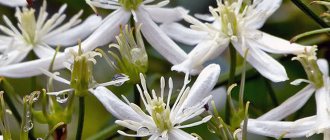Frost-resistant varieties
In Russia, wild weigela is found in Primorye. Three varieties of this deciduous shrub grow there: pleasant weigela, middendorf weigela and early weigela. Twice a year the shrub is covered with funnel-shaped flowers of various shades. At the same time, the shade of the petals gradually changes, becoming darker.
Important! All varieties of weigela require shelter for successful wintering. In regions with snowy winters, snow is used as additional protection and thrown on top of the bushes.
Species with the greatest frost resistance
For residents of Russia, especially in the northern regions, one of the defining characteristics of weigela is frost resistance. Therefore, it is preferable to choose the following types of weigela:
| Species name | Description | Frost resistance |
| Weigel Middendorf | A shrub up to 1.5 m tall, it blooms twice a year with yellow flowers in the form of inverted funnels. The flowering period lasts 30 days | up to -15 degrees |
| Weigela japonica | The height of the bushes is 1 m. During flowering, it is covered with funnel-shaped flowers up to 3 cm long, carmine in color. | up to -15 degrees |
| Weigela is nice | The length of the shoots is up to 1.3 m. During flowering, which occurs twice per season, funnel-shaped flowers of burgundy color with a light pink inside bloom on the branches | Tolerates frosts well |
| Weigela early | The bushes grow up to 1.5 m tall. During flowering, they are covered with beautiful flowers, pink on the outside and burgundy on the inside. Flowering lasts 1 month | up to -15 degrees |
| Veigel Maksimovich | The height of the shoots is 1.5 m. Light yellow, bell-shaped flowers appear in mid-May. Flowering lasts 1 month | up to -10 degrees |
Popular varieties
Weigela is distinguished by a variety of varieties, but those that have good resistance to frost are more suitable for the Russian climate. The following varieties are especially popular among domestic gardeners:
- The Pink Princess variety is easy to care for and has good endurance. In the south of Russia, in regions with a mild climate, it can be grown without insulation for the winter.
- The Purpurnaya variety forms bushes 1.5 m tall. Flowering occurs in mid-summer. At this time, the bush is covered with beet-colored flowers with a creamy core. It has good frost resistance, but in the northern regions it needs to be closed.
- The Alba variety forms bushes up to 3 m in height. It blooms with white flowers, gradually changing color to pink. Differs in average resistance to frosts.
- The Nana Variegata variety grows up to 1.5 m in height and is distinguished by unusual decorative leaves with a light edge. Flowering occurs in the second half of May. Frost resistance is up to -12 degrees. Therefore, shelter is required in the northern regions.
Description
This shrub is native to East and Southeast Asia. There are 3 native species growing in the Russian Far East, and another 9 are “migrants”. Weigela is a perennial plant, famous for its leaves of unusual shape and color, as well as a variety of bright color variations in its inflorescences.
As for the characteristics of the plant, we can say the following:
- weigela growth ranges from 35 cm to 3 m, depending on the variety;
- leaves are located opposite each other, do not have stipules;
- flowers are bell-shaped or funnel-shaped, the color varies from white to deep red;
- Each flower has 5 petals;
- Weigela usually blooms in summer, from June to August;
- the fruits are presented in capsules with two doors; inside there are small angular seeds that are quickly dispersed by the wind.
Weigela loves moisture and sun, but also tolerates shade quite well. For propagation, cuttings and ripe seeds are used, which are best sown in early spring in greenhouses.
The wide variety of varieties of this plant makes it easy to choose the best option for growing in certain climatic conditions, even as far from eastern Asia as the Moscow region.
General Tips
Growing this plant in the garden is not difficult. To prepare weigela for winter, caring for it in the fall consists of performing the following mandatory activities:
- glaze;
- applying fertilizers with a high concentration of potassium;
- mulching the tree trunk circle;
- formative pruning;
- insulation in the fall using a frame or frameless method.
How to cover a bush
Each gardener has his own ways of preparing weigela for wintering. Two methods are most often used, depending on the age and height of the plant, as well as the growing climate:
- Frame. It is convenient to completely hide bushes that are not very tall by building a kind of house for them. To do this, install arcs over the plant and stretch a film over them, or even better - lutrasil. The ends of the film are sprinkled with earth. In northern latitudes, spruce branches are also placed on top of the frame.
- Bending down shoots. This method is suitable for mature large shrubs. In order not to build entire greenhouses, it is more advisable to carefully bend the branches in an arc, wrap them in burlap and secure them with staples. First, mulch the soil under the bush with spruce branches - this way the shoots will not lie on the ground. The weigela laid “on its side” is covered with roofing felt - now this will be easier to do.
Whatever method is used, you should start covering weigela no earlier than the first frosts arrive. Otherwise, the branches may dry out. In addition, this must be done in dry weather. Shoots and soil should not be wet.
Closer to spring, you need to monitor the weather and remove the shelter in time as soon as severe frosts pass. The sun is already beginning not only to shine, but also to warm. A covered weigela will probably not resist fungus and rot if it is not freed.
Autumn pruning of weigela
Shearing is a mandatory procedure for all varieties of deciduous crops. If pruning is carried out on time, the wounds on the shoots will soon heal, and the bush will acquire aesthetic appeal. Cutting off unnecessary shoots increases resistance to winter cold.
You need to trim weigela to solve the following problems:
- stimulating the growth of young shoots;
- giving the correct crown shape to adult plants;
- abundant flowering next year;
- rejuvenation;
- improving resistance against diseases.
You may be interested in:
Pruning honeysuckle: when and how to do it correctly, features, schemes Summer residents plant honeysuckle in their plots because it is unpretentious and easy to look after. Amateur flower growers…Read more…
Trim time
Removal of branches for sanitary purposes from shrubs is carried out in the spring. During this procedure, all diseased, broken or frost-damaged branches are cut out. In autumn, formative and rejuvenating pruning is carried out. The purpose of this procedure is to give the crown of the bush an aesthetic appearance and, if necessary, remove old shoots that no longer produce flowers.
When it is not possible to prune the plant twice a year, it is preferable to carry out the autumn procedure. For weigela it is of greater importance. In the spring, only a few branches are removed, which are not of great importance for the development of the bush.
Important!
They begin to trim the shrub in the fall immediately after the end of re-blooming. It usually ends in September or until mid-October.
Pruning technique
Before you begin to remove all unnecessary branches, the soil in the circle around the trunk and the lower part of the plant are sprayed with a solution of any fungicide. This will protect the bush from infection with fungal diseases. Then trim according to the following instructions:
- Cut all affected, broken branches 0.5 cm above the second healthy bud.
- Cut off poorly developing branches completely.
- Remove a third of the old branches to rejuvenate the bush and stimulate flowering.
- Thin out the shoots directed deeper into the bush to reduce crowding.
- Shorten the branches protruding from the general crown and completely remove the fallen ones to improve their decorative qualities.
If pruning is carried out for rejuvenating purposes, all branches older than three years are cut out completely, and younger ones are cut off by a third. If the bush is too neglected, then all the branches are completely removed, leaving only a stump of the bush.
Care after pruning
Having removed all unnecessary branches, the remaining wounds on the bush are covered with garden varnish. After this, the plant is fertilized with mineral complexes with a high concentration of potassium or potassium sulfate and potassium chloride are used for this. These fertilizers have a strengthening effect on weigela. When applying fertilizer, follow the manufacturer's instructions. Another feeding option is mullein diluted with water in a ratio of 1:10.
Important!
For weigela in the fall, do not use mineral fertilizers with nitrogen. This substance slows down the lignification of shoots and provokes putrefactive processes.
Pruning weigela in spring, after flowering and in autumn
Immediately after planting, while the plant is still young, it is recommended to immediately begin to give it the desired shape, i.e. carry out formative pruning (haircut).
Advice! If you want a ball , then leave a lot of short branches, shortening them every year. If you want a tree on a trunk , first grow this trunk, i.e. Let one shoot grow upward, and remove the rest completely.
Alternatively, you can grow weigela on an intertwined trunk of several (3) shoots.
Video: weigela on an intertwined trunk
As for the timing of pruning, in the spring, as a rule, sanitary pruning is carried out after winter, cutting out frozen branches.
The fact is that in the spring you can clearly see which branches and buds to leave (they are alive), and which to remove and shorten (they are frozen).
Accordingly, before flowering, it is advisable to cut out only damaged (broken), frozen or unsightly protruding branches, for example, hanging near the ground (spoiling the appearance of the bush).
Important! You should always cut to the bud, i.e. make a cut immediately above the bud and leave a stump of no more than 0.5-1 cm.
In general, at this time (early spring) you can trim your bushes, i.e. do formative pruning, but it is better to do this after flowering or late autumn (but only after leaf fall, so that the buds do not awaken).
Trim = shorten the ends to encourage the growth of side shoots and new shoots. As a rule, they are shortened by 1/3 of the length, or maximum by 2/3.
You need to shorten first of all, focusing on the shape of the bush.
As you know, weigela blooms for the first time on the shoots of last year, and the second time - on the shoots of the current year (naturally, more sparingly).
Autumn re-blooming ends
Accordingly, abundant and repeated flowering of weigela will depend on its timely and regular pruning.
So, if you want to see the weigela bloom again, then immediately after flowering you will need to trim off all the faded flowers (the ends of the faded branches).
Advice! If every year after flowering you shorten last year's branches (shaping), the bushes will be more compact and easier to cover.
rejuvenate the bush every 3-4 years by removing all the old 3-4 year old branches.
Video: flowering and formation of weigela
Weigela shelter for the winter
Weigela's resistance to frost increases with age. Therefore, plants older than 5 years do not need additional winter shelter. Young specimens that have recently undergone transplantation, or those that are sick, must be closed in the fall to increase the likelihood of survival in winter frosts. In addition to low frost resistance, weigela bushes are covered with dense material for the winter due to the structure of the branches. They are very fragile and easily break due to the weight of snow.
A shelter for weigela is built after the final cold snap. This is done in two ways.
To cover the weigela for the winter, build a frame:
- Wooden or metal arches are placed above the plant so that the distance between them and the shoots is 5-10 cm.
- Cover the frame with film or other dense material. They secure it from below with stones or add soil.
- If severe frosts are typical in winter, straw or hay is thrown on top.
Another method for covering weigela for the winter is to bend down the shoots:
- The ground in the circle around the trunk is mulched with spruce branches, tops or brushwood.
- The branches are pulled together in a loose bundle and wrapped in burlap.
- Bend the resulting structure to the ground and secure it with staples.
- Fill the top with mulching material and cover it with roofing felt.
Important!
Cover the bush only on a dry, frosty day. Otherwise, a fungal infection will form under the cover and a putrefactive process will develop.
Diseases and pests
Cultivated varieties of weigela are distinguished by noticeable resistance to diseases and insect pests. Despite this, plantings are often attacked by aphids and scale insects. You may also be exposed to leaf-eating caterpillars, spider mites and thrips. To combat them, you only need to treat the bush a couple of times with any suitable insecticidal preparation. You can also use environmentally friendly folk remedies - for example, a tincture of garlic or hot pepper.
The plant is susceptible to diseases such as gray rot, leaf spot (bacterial and fungal), and root collar cancer. Treatment of the first two types of infections is determined by the degree of damage to the bush. If you managed to catch the disease at the initial stage, you need to remove all the affected parts of the plant and burn them. And treat the bush itself with a bactericidal or fungicidal preparation (for example, Bordeaux mixture, copper sulfate solution or complex agents).
If spherical growths appear on the root neck of the bush, gradually hardening and becoming covered with woody crust, there is only one way out - to destroy the plant that has become infected with bacterial cancer. There is currently no effective treatment for this disease, and in order to prevent infection of other specimens, the cancer-affected bush must be burned.
Don’t forget about prevention, because it is much easier to prevent illness than to deal with the consequences of infection later. To do this, the soil is treated several times with a solution of potassium permanganate or Bordeaux mixture. The first time such treatment should be carried out in early spring, when nature begins to awaken from a long winter sleep. You can treat the bushes a second time (optional) during the period when buds are setting - this is the time when any plant is most defenseless. The land is cultivated for the third time in late autumn, before covering the weigela for the winter.
You can learn more about weigel from the video below.
Preparing weigela for winter by region
The nature of the winter shelter for flowering shrubs is determined by the climate in the cultivation region. In the central part of Russia and in the Moscow region, they mainly use the frame method, additionally throwing rags or hay over the shelter before severe cold weather.
In the Volga region, weigela is bent to the soil to protect it from winter cold. And for the Urals and the Siberian region with harsh winters, after bending the bush to the ground, it is additionally covered with mulch and building materials. In winter, snow is thrown on top for additional insulation.
In southern regions with warm winters, minimal shelter is sufficient for weigela. The soil in the circle around the trunk is mulched with suitable material, and a small mound of soil is poured around the trunk.
Care in winter and spring
In winter, after a snowfall, it is advisable to throw more snow into the trunk circle of the bush and on the sides of the shelter, but shake it off from the top. If too much snow has fallen, check the integrity of the frame so that it can withstand the load and the weigela does not break or spread.
Removing cover
You need to remove the shelter in the spring after the end of serious frosts and snowfalls. Among the popular signs, one can highlight the following: if Easter is early, then it can be revealed earlier, and if it is late, then later.
For example, in the Moscow region it is better to open weigela no earlier than April 3, and young bushes no earlier than April 10-11. Although some gardeners remove the cover at the end of March and are satisfied with the condition and development of the bush.
Sanitary pruning
Unfortunately, no matter how hard we try in the fall, weigela does not always overwinter without noticeable damage. Even in the Moscow region, except for the city of Moscow and certain places with a very favorable microclimate, the bush is often severely frozen.
In April, inspect the bush and if there are frostbitten shoots, cut them back to the first living bud. Some shoots have to be cut by 10-15 cm, and some branches have only the tops. It is also necessary to remove diseased and old branches.
What to do if the weigela is severely frozen in winter?
If the bush has been seriously damaged during wintering, then it needs to be watered more often in spring and summer, especially in hot and dry weather. Watering rate is 8-10 liters of water per bush. The frequency of watering depends on the amount of precipitation and temperature; the hotter, the more often.
Abundant watering will help the plant quickly regain its strength and prepare for winter. For many gardeners, weigela comes to life by July or August, and sometimes as early as next spring.
Top dressing
During snow melting or immediately after removing the cover, we recommend feeding the weigela with complex mineral fertilizer with a higher proportion of nitrogen than potassium and phosphorus. You can also use fertilizers separately: nitrogen (urea), potassium, phosphorus (superphosphate) - 20, 10, 10 grams per 1 m².
Spring feeding contributes to better recovery of the bush after winter.
Mulching
The best time for mulching is when the ground has already warmed up well after the snow has melted, but is still quite wet. Approximately: mid-April – early May, depending on the region and weather conditions.
Pour a 4-6 cm layer of sawdust, shavings, pieces of pine bark, peat or small pebbles into the tree trunk circle.
We wish you a wonderful mood and bright thoughts!
Features of growing weigela early
This type of deciduous shrub prefers to grow in a well-lit area, protected from drafts. Select an area with loose soil for planting. If the soil does not meet the required characteristics, additional sand and humus are added.
A hole for weigela is dug with sides of 50 cm. Then a bush is placed in it and buried. Afterwards the soil is compacted and the plant is well watered. When planting, plants are placed so that their branches do not touch.
You may be interested in:
Caring for buddleia for the winter: how to prune, insulate, features of autumn replanting. The homeland of lush flowering buddleia is China. Although this exotic plant has adapted to the harsh Russian...Read more...
Preparing for winter
Caring for weigela in the fall to prepare for winter involves insulating it with spruce branches. It is laid out in a circle around the trunk, capturing the lower part of the trunk. Instead of spruce branches, use peat or sawdust. Then the bush is tightly tied and a wire frame is installed over it. It is covered with agrofibre, lutrasil or other covering material.
Features of care
In summer, weigela is watered regularly. In sultry and hot summers, the bush is irrigated every day using 5-8 buckets of water. To reduce moisture loss, the soil is regularly loosened and mulched with suitable material. This procedure is also useful for reducing weeds. The mulch layer is laid 4-6 cm thick.
In spring and summer, weigela is fed with mineral complexes containing all the substances the plant needs. In August, fertilization is stopped so that the shoots have time to become woody and prepare for winter. After the snow melts, weigela is fed with phosphorus-potassium fertilizers or organic matter.
Reproduction
Early weigela is propagated mainly by cuttings. To do this, cut cuttings up to 12 cm long with two live buds. The cuts are made straight.
Important!
Weigela cuttings are carried out in April or May.
Rooting of cuttings is performed in the following order:
- Treat the lower cut of the cutting with a growth stimulator.
- Leave the prepared planting material in a darkened room for 12 hours.
- Place the cuttings in a peat-sand mixture for rooting to a depth of 0.5 cm.
- Cover the shoots with sand and cover the container with film or glass to create a greenhouse effect.
- 40 days after planting, roots appear.
- After this, the young seedlings are grown for one and a half years before being planted in a permanent place.
Another way of propagating weigela is by seed. Seeds are planted superficially in wooden boxes filled with fertile soil. They are sprinkled with sand on top and the container is covered with film or glass. The first shoots appear after 3 weeks.
Autumn feeding of weigela after flowering
It’s probably no secret that for better wintering, all perennial plants require phosphorus-potassium fertilizers.
Therefore, after the second flowering, in September, feed your weigels with one of the following autumn fertilizers:
- Option 1 - superphosphate + potassium sulfate (potassium sulfate);
- Option 2 (the most effective, but expensive) - potassium monophosphate;
- Option 3 - any ready-made specialized complex fertilizer marked “autumn”.
Possible mistakes in care and preparation for winter
Most often, gardeners do not properly care for deciduous crops and make mistakes in preparing for wintering due to lack of experience. The main ones are:
- Arrangement of shelter until frosty weather finally sets in. This leads to damping off of the plant and infection with fungal diseases.
- Covering a wet plant or bending shoots to damp soil. This also leads to rot and damping off.
- Pruning should only be done after reaching the age of three. During this time, the bush grows greatly, the crown takes on an irregular shape and further pruning takes several years.
To maintain viability, weigela needs to be trimmed every year and well covered for the winter. It is important to carry out the work on time and in the specified order. Then the plant will successfully survive the frosts and will delight you with abundant flowering in the summer.
The best varieties to grow
To grow near Moscow, you should select winter-hardy varieties, otherwise the plant will please you for only one season. Let's consider some types of weigela suitable for cultivation in central Russia.
- Hybrid. Various varieties of hybrid weigela are obtained through artificial crossing of wild species. One of their valuable qualities is the possibility of repeated flowering. Among the most frost-resistant, names such as “Candida”, “Bristol Ruby”, “Styriaka”, “Lucifer”, “Nana Variegata”, “Gustav Malle” should be highlighted.
- Blooming. Advantages of this species: drought resistance, abundant flowering, small size. Winter hardiness is at an average level, so in the cold season these shrubs need shelter. Popular varieties: “Elvera”, “Alexandra”, “Pink Princess” and others.
- Sadovaya. Valuable qualities: fast growth, good drought and frost resistance, ease of reproduction. Requires a lot of sun. In shaded areas, growth slows down and the number of flowers decreases.
- Early. A distinctive feature of this species is the crown of an almost regular spherical shape. Just like the garden one, it grows quickly, blooms well in sunny areas, and tolerates heat and frost well. If the summer weather is dry and hot, the plantings will need to be watered.
Required Tools
Weigela is a rather delicate plant. Its branches rarely become woody, and therefore they are pruned without the use of bulky tools. At a minimum, a gardener should have gardening scissors or pruning shears in his arsenal. If a shrub remains in the shade for a long time, its branches may become covered with dense bark.
In this case, the oldest shoots will have to be removed with a small hatchet or saw. After the pruning procedure, the sections must be treated with garden varnish. Therefore, you will need a brush. All work should be carried out with gloves - made of fabric or rubber.
How to properly care?
Caring for weigela is not particularly difficult. Winter-hardy varieties do not even require shelter in the cold. Of course, in this case, young branches may freeze, but when spring comes, the plant quickly comes into shape. If the winter is expected to be harsh and with little snow, it is better to cover the plants (especially young ones) with dry leaves, agrofibre or spruce branches.
Watering
Do not allow the soil in which the shrubs were planted to dry out. If the weather is hot, mulch the top layer of soil with dry spruce needles, grass or peat to prevent excessive evaporation of moisture. Water your ornamental plantings regularly and generously.
How to plant?
To plant this light-loving plant, select places generously illuminated by the sun and protected from gusts of wind. Lack of lighting negatively affects the abundance of flowering, the shape of the crown, the color of the leaves and the duration of seed ripening. It should also be noted that when grown in shaded areas, weigela branches remain soft for a long time.
The soil requirements are not so severe: any soil is suitable for weigela, of course, provided that it is fertile, loosened and slightly moist.
The best time to plant seedlings in open ground is spring. To do this, you will need to dig a hole about 50x50x50 cm. Coarse sand or gravel should be poured onto the bottom to ensure good drainage: the roots of the bush are too thin, and if the water stagnates, they will simply begin to rot. Place the seedling in the ground and carefully cover it with soil. At the same time, do not bury the neck of the roots into the soil - it should remain flush with the ground. Moisten the soil around the seedling using a watering can. Cover the ground around the planting with an 8-10 cm layer of sawdust or any other mulch mixture (leaves, peat, pieces of bark).
Recommended pruning times
Weigela can be compared to lilacs in terms of its tolerance to pruning. You can cut it in spring, summer and autumn - the bush will not get sick or die, it will only produce new shoots. The timing of haircuts is mainly chosen for the convenience of the grower. In summer, plants are covered with dense foliage; among the greenery, it is very difficult to determine which shoots should be removed or shortened. It is better to do this work in early spring, before the buds open, or in the fall, after the leaves have fallen.
Look at your bushes in early spring and you may notice the black tips of some of the branches. This happens when the shoots freeze in the cold winter. Wait until the buds begin to swell and cut off the damaged areas at a distance of 1 cm above the outermost living bud. If such a sanitary pruning seems too tedious to you, do not delay pruning in the fall until the coldest weather, trim the bushes 20 days before the onset of frost. In 3 weeks the branches will get stronger and overwinter well.
The bushes will develop well if you trim them twice a season. After wintering, branches frozen or broken by snow will remain on the weigel. If you do not remove them, the damaged fragments will rot and become a source of infection for the entire bush. Over the summer, some shoots will become diseased, and some will become infected with pests.
Since weigela is a rather unpretentious plant (and for this reason it is compared to a lilac bush), the crop can be cut at any time: spring, summer and autumn, at a time convenient for you, excluding only the winter months. Even during flowering, it is impossible to harm the weigela by pruning, since the bush easily reacts to this, producing more and more young shoots.
There are several types of haircuts:
- formative;
- sanitary;
- rejuvenating.
As a rule, pruning is done after flowering. Summer and autumn are more suitable for shaping the shape of the bush. Sanitary pruning is done in early spring, removing all rotten and frozen branches after wintering. They are easy to identify: a sign of freezing of branches is blackening of the tips.
In spring, pruning the plant is very convenient, because this is done even before the leaves bloom, which gives a good overview of all the shoots. It is easy to figure out which branches have already become obsolete and which have living buds. The rejuvenation procedure is carried out in spring or autumn before wintering, after the leaves have fallen. This will allow the stumps time to strengthen and gain strength, so that upon awakening after winter they will again grow into dense and numerous shoots.
Let us consider in detail how to form, renew and improve the health of the bush with the help of a haircut.
Weigela is divided into 3 types according to size:
- dwarf;
- average;
- high.
In dwarf varieties, the height reaches only half a meter, medium varieties grow up to one and a half meters, and tall ones - up to two and a little more. Of course, dwarf weigels should not be cut very short, and they only require sanitary pruning, which consists of removing diseased, damaged and weak branches. And also over time, when the bush becomes old and stops blooming luxuriantly, you can rejuvenate it.
But medium and tall plants need more careful and frequent pruning. The pruning procedure is very simple even for novice gardeners and will not pose any difficulties. Forming a bush must begin 2-3 weeks after planting.
To give it the shape of a ball, you need to shorten the branches from below, near the trunk, by a third of the total length, then gradually trim them, leaving the ends longer and longer, and so on until you reach the middle. From the middle, the procedure is repeated, only in reverse order. And so on in a circle to achieve a spherical shape.
Weigel can be easily transformed into other geometric shapes. Triangles, cubes, spirals, waves and even animal shapes. To form the figure of an animal, it will be better and easier to build a kind of wire frame, and let the plant grow in it. Then it will be enough to simply cut the branches to shape. You only need imagination and certain skills, but if you want, everything will work out.
If you want to give the shrub the shape of a tree, then choose one of the smoothest and most beautiful shoots, and remove the rest. This will be your future trunk. You can also form a trunk from several shoots. They can be twisted around each other or braided, thereby giving an unusual shape. In any case, you first need to grow a stem, and then begin to form a crown on it.
For sanitary pruning, as well as for the health and renewal of the bush, it is necessary to trim the shoots above the bud, leaving 0.5 to 1 cm of the trunk on top. Throughout the season, it is necessary to thin out the plant from time to time for free air circulation, good lighting and the appearance of new shoots.
Just don’t overdo it, since the shrub blooms in the second year of its life and if you remove a lot of last year’s shoots, then don’t expect lush flowering. And in order for weigela to please you with repeated flowering, you need to remove all faded inflorescences, cutting off part of the top of the branches by 2-3 cm.
To rejuvenate the plant, upon reaching 3 years of age, it is necessary to completely cut off all the trunks, leaving stumps approximately 10 cm high. The cut areas should be immediately treated with garden varnish or any fungicide; it would not be superfluous to treat the soil around the bush with it. You can cut off the entire plant, along with the young growth, or you can shorten only the old branches. New shoots will subsequently emerge from them.
If you want to see long and lush flowering of weigela, pruning the bush should be done in a timely manner. This plant is suitable for various decorative purposes: you can decorate an ugly fence, create a green hedge, make a low bush as a central element in a flower bed, or come up with an entire composition. Learn how to properly trim an ornamental plant; your imagination will tell you what to do next.
It is best to start cutting weigela either after flowering or after leaf fall. The exact time depends on the growing climate. In the south, you can cut weigela until mid-October, since autumn there is long and warm.
The Far East is considered the homeland of the shrub, which determines the heat-loving nature of the plant. Of the 15 existing species, there are those that feel comfortable even in regions with a cold climate. However, they require proper care.
Pruning shrubs is considered a kind of preparation for the cold season. This is an important procedure that should not be neglected, because it:
- increases the “immunity” of the plant - after the procedure it becomes more resistant to cold and pests;
- rejuvenates – the growth of new shoots is activated;
- forms a bush - it is with the help of pruning that the weigela is given the required shape;
- activates abundant flowering.
Autumn is a transitional period before wintering. The shrub is no longer so active, its growth slows down, and it gradually “falls into hibernation.” However, this is the time that is considered the most favorable for pruning. The cuts heal quickly and by the onset of winter the bush is completely unharmed. If you prune a plant in the cold season, its “immunity” is significantly weakened and becomes more vulnerable to low temperatures.
It is better to remove branches after the second flowering, which is September-October. For pruning to be effective, you need to:
- treat the trunk and soil near the plant with fungicides;
- remove old and underdeveloped shoots;
- thin out the branches growing in the middle of the bush.
Branches older than three years are removed completely, and young ones - by a third of their length.
After removing the branches, the sections should be treated with garden varnish, this will speed up the healing process. Caring for weigela in the fall involves the use of fertilizers and fertilizing. The most useful are those that contain a lot of potassium, which strengthens the branches. As for organic fertilizers, mullein solution is an excellent option.
Watering is an equally important aspect in caring for a bush. It must be done as the soil dries. Moisture is able to retain heat in the soil longer, which will prevent excessive freezing of the root system.
We invite you to familiarize yourself with Nitrofoska - a complex fertilizer. Composition, characteristics, application
Organic mulch made from spruce needles, bark or straw can retain moisture in the soil. Compost should be spread in the root zone of the bush in a layer of 15–20 cm. The mulch should not come into contact with the weigela trunk, otherwise it will begin to rot.
The shrub tolerates any type of haircut perfectly. It is considered to be as resilient as lilac. Therefore, you can cut “extra” shoots throughout the entire season - from spring to autumn. In this case, the plant will not get sick or die. In addition, new branches will appear quite quickly.
In most cases, the choice of time period for pruning is made by the gardener himself. Summer is not the best time for sanitary pruning. Indeed, in dense foliage it is difficult to notice damaged shoots. Therefore, many summer residents choose early spring for this purpose. In this case, it is necessary to make sure that the process of circulation of juice in the tissues has not begun in the plant. An alternative is considered to be autumn, when the foliage has completely fallen off.
Did you know? The popular technique of bonsai formation is taught on indoor weigela bushes.
In spring, you should carefully inspect the bush. Sometimes characteristic black dots appear on the upper parts of the shoots. Such new growths indicate that in winter the weigela was exposed to frost. In this case, you need to wait until the buds begin to swell. Below the blackened area (1 cm) pruning is carried out. The main condition is not to affect the first healthy kidney on top.
About propagation of weigela by cuttings in autumn
- Weigela begins preparing cuttings for propagation at the end of summer. Branches about a centimeter thick, reaching a length of up to two tens of centimeters, are suitable for cuttings. After pruning, the lower leaves are removed and kept in a growth stimulator.
- Until spring, the cuttings are placed in the ground. There is no need to dig holes in the garden bed for them. It is better to choose a shaded place for planting cuttings. Soil preparation begins with the addition of humus. If the soil is acidic, then add lime to the garden bed.
- The cuttings are placed to a depth of 10 cm, leaving a distance of up to a quarter of a meter between neighboring plants, the soil is compacted and watered.
- After a year, the cuttings are replanted half as often. And after a couple of years, they are buried at an angle, completely covering the roots and part of the crown with soil, so that wintering goes well. Before this, prepare a planting hole with a volume of 50 by 50 cm, fill it with the same amount of humus and sand and half the volume of turf soil. It is also possible to fertilize the soil with two buckets of compost and 100 grams of nitrophoska.
Bushes are planted at a distance of two meters from each other if they are tall varieties of shrubs and half as often if they are short. The root collar of weigela should be at soil level when planting. After the soil shrinks as a result of watering, it will lower by a couple of centimeters, which is necessary for the successful wintering of the shrub.
When to open weigela after winter
Caring for weigela in the spring is designed to restore the plant after winter, stimulate the growing season and prepare it for abundant flowering. Already in March, before the winter shelter is removed, the bush is fed with mineral complexes.
The cover from weigela, as well as from other ornamental heat-loving shrubs, is removed, adhering to the following rules:
- You can start the procedure when the danger of frost has passed. In the middle zone, as a rule, the plant is opened at the beginning of the second ten days of April;
- you need to start by ventilating the shelter without removing it completely;
- holes should be made in the covering material for gradual access of air;
- The mulch that has compacted over the winter needs to be loosened a little to ensure access of fresh air to the roots;
- It is best to remove the cover on a cloudy day so that the bush can adapt to the spring sun and not get burned;
- It is recommended to shade the bushes within 1 – 2 weeks after removing the insulation.
Attention! You cannot keep the shrub under cover during spring thaws, as this leads to damping off.
After the cover is removed from the weigela, sanitary pruning of the bush is done to remove all frozen and damaged branches.
Some gardeners, after overwintering weigela in open ground, complain that the plant has dried out. If this happens, moderate but regular watering will most likely help. Even when the plant looks completely lifeless, thanks to periodic irrigation, by the summer it will be able to grow again from the remaining buds, and in some cases will even bloom in the same season.



